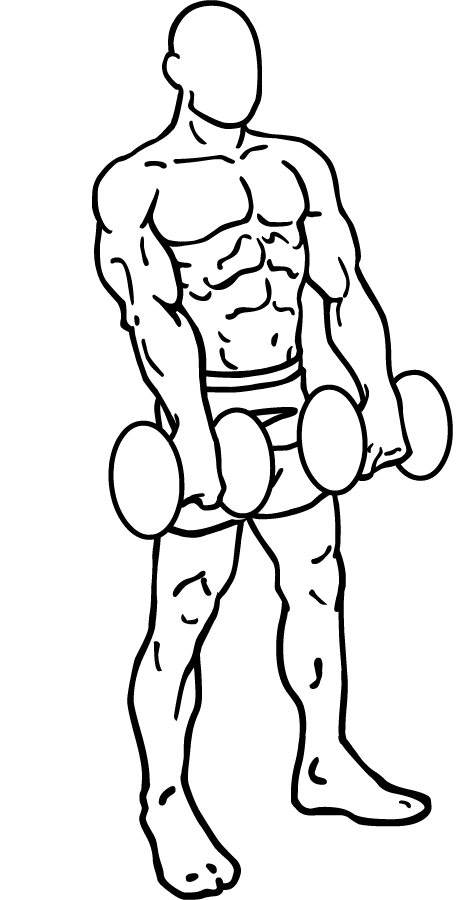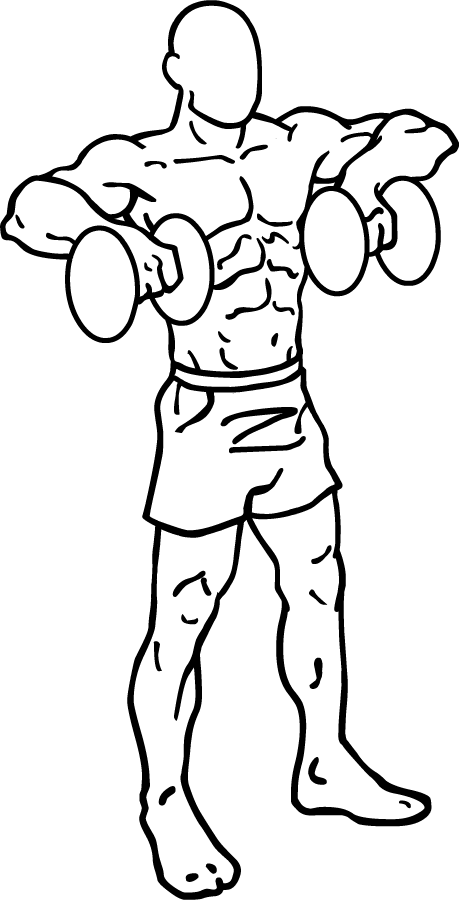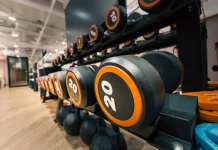Last Updated on September 30, 2014
When it comes to building strong, sculpted shoulders and toned biceps, the Dumbbell Raise is an essential exercise. It’s a highly effective movement that engages multiple muscle groups, focusing on the deltoids, trapezius, and biceps. Whether you’re aiming to enhance shoulder strength, boost upper body definition, or increase overall arm stability, this exercise can be a powerful addition to your workout routine.
In this guide, we’ll break down everything you need to know about the Dumbbell Raise—what muscles it targets, the benefits it offers, proper form, common mistakes to avoid, and how to integrate it into your existing fitness regimen.
Why the Dumbbell Raise?
The Dumbbell Raise is a versatile and dynamic exercise that belongs in any upper-body workout. It not only helps develop the shoulder and bicep muscles but also improves posture and overall shoulder stability. Here are some reasons why this exercise is worth incorporating into your routine:
- Targets Multiple Muscle Groups: While primarily focusing on the shoulders (deltoids) and biceps, the Dumbbell Raise also works other muscles, such as the trapezius and rhomboids. The involvement of these stabilizing muscles helps improve overall upper body strength and endurance.
- Improves Shoulder Mobility: By performing the Dumbbell Raise with controlled movements, you enhance shoulder flexibility and mobility, reducing the risk of injury during other compound exercises like the bench press or overhead press.
- Versatile and Accessible: This exercise requires only a pair of dumbbells, making it suitable for both gym-goers and home workouts. It can be performed in various settings without the need for extensive equipment.
- Aids in Muscle Definition: The Dumbbell Raise, when done with proper form and consistency, helps tone and define the upper arms and shoulders, contributing to a more balanced and aesthetic physique.
Muscles Targeted in the Dumbbell Raise
Before diving into the step-by-step instructions, it’s important to understand the key muscle groups that the Dumbbell Raise engages. Here’s a quick breakdown:
- Deltoids: The main muscle activated during a Dumbbell Raise is the deltoid, which consists of three parts—anterior (front), lateral (middle), and posterior (rear). This exercise primarily targets the anterior and lateral deltoids, helping create round, full-looking shoulders.
- Biceps: As the arms lift the dumbbells, the biceps work as secondary muscles to assist in the movement. They play a crucial role in stabilizing the dumbbells, which helps develop strength in this area.
- Trapezius and Rhomboids: These muscles, located in the upper back, assist in the lifting motion, especially during the controlled descent of the dumbbells. They help support shoulder elevation and retraction, enhancing your upper back stability.
Step-by-Step Guide to Performing the Dumbbell Raise
Equipment Needed:
- Two dumbbells: Start with a light weight (e.g., 5–10 lbs) to perfect your form before gradually increasing the load as you build strength.
Starting Position:
- Stand Upright: Begin by standing tall with your feet shoulder-width apart. Maintain a slight bend in your knees to stabilize your body and avoid unnecessary strain on your lower back.
- Hold the Dumbbells: Grasp a dumbbell in each hand with your arms fully extended, palms facing inward (neutral grip), and the dumbbells resting in front of your thighs. Keep your shoulders back and chest open.
- Engage Your Core: Draw your abs in and brace your core to support your spine throughout the movement. This will help you maintain balance and prevent injury as you lift the weights.
The Movement:
- Initiate the Raise: Begin the lift by bending your elbows slightly and raising the dumbbells on either side of your ribs in a rowing motion. Your elbows should move outward in a wide arc, while your hands follow the natural path of your body.
- Focus on Controlled Movements: As you lift the weights, focus on squeezing your shoulder blades together. Avoid swinging or using momentum to lift the dumbbells—control is key to properly engaging the shoulder muscles.
- Pause at the Top: Once the dumbbells reach the height of your chest, pause for a brief moment to feel the contraction in your shoulders and upper arms.
- Lower with Control: Slowly lower the dumbbells back to the starting position, resisting gravity as you return. This controlled descent is crucial for muscle activation and preventing injury.
- Repeat: Perform the exercise for 8–12 repetitions, depending on your fitness level and the weight you’re using. Complete 3–4 sets to maximize results.
Common Mistakes to Avoid
Proper form is essential in the Dumbbell Raise to ensure you’re targeting the right muscles and preventing injury. Here are some common mistakes to watch out for:
- Using Too Much Weight: It’s tempting to grab the heaviest dumbbells, but this can compromise your form. Start with lighter weights and increase only when you can comfortably complete a full set without losing control.
- Leaning Back: As the dumbbells rise, avoid arching your back or leaning backward. This can strain your lower back and take the focus away from your shoulders. Engage your core and keep your spine neutral throughout the movement.
- Swinging the Weights: Using momentum to lift the dumbbells reduces the effectiveness of the exercise. Always lift and lower the weights with slow, deliberate movements.
- Overextending the Arms: Fully locking out your elbows at the top of the movement can place undue stress on your joints. Keep a slight bend in your elbows to maintain muscle engagement and protect your joints.
Variations of the Dumbbell Raise
To keep your workouts challenging and dynamic, consider incorporating these variations of the Dumbbell Raise into your routine:
- Front Dumbbell Raise: Instead of lifting the dumbbells to your sides, raise them directly in front of you. This targets the anterior deltoids more intensely and adds variety to your shoulder training.
- Lateral Dumbbell Raise: For a wider range of motion, focus on lifting the dumbbells out to the sides while keeping your palms facing downward. This emphasizes the lateral deltoids and helps build shoulder width.
- Alternating Dumbbell Raise: Perform the movement with one arm at a time. This variation enhances coordination and balance while still targeting the shoulders and biceps.
- Bent-Over Dumbbell Raise: Modify the angle by bending your torso forward at a 45-degree angle. This version focuses more on the rear deltoids and upper back muscles.
- Cable Dumbbell Raise: Using a cable machine instead of dumbbells can provide constant tension throughout the movement, leading to improved muscle activation.
How to Incorporate Dumbbell Raises into Your Workout Routine
The Dumbbell Raise can be performed as part of your upper-body day or shoulder-focused workouts. Here are some ideas on how to integrate it into your routine:
- Shoulder Day: Pair the Dumbbell Raise with other shoulder-specific exercises like Overhead Press, Arnold Press, or Lateral Raises for a complete shoulder workout.
- Full-Body Workouts: Include the Dumbbell Raise in full-body routines to ensure you’re targeting your shoulders and arms along with your lower body and core.
- Supersets: Combine Dumbbell Raises with other bicep or shoulder exercises in supersets to maximize muscle fatigue and stimulate growth.
- As a Finisher: Use the Dumbbell Raise as a finisher after heavy compound lifts to ensure your shoulders and biceps are fully taxed by the end of your workout.
The Dumbbell Raise is an excellent exercise for anyone looking to strengthen and define their shoulders and biceps. With proper form, controlled movements, and consistent practice, this simple yet effective exercise can help you achieve balanced upper-body development.
Remember to start light, focus on your form, and gradually increase weight as your strength improves. Add in variations to keep your workouts fresh and challenging, and you’ll be well on your way to stronger, more defined shoulders and arms.
By incorporating the Dumbbell Raise into your regular routine, you’ll not only enhance your strength but also reduce the risk of injury and improve your overall posture. So grab those dumbbells and get ready to lift your way to stronger shoulders and arms!


Exercise images by Everkinetic.






